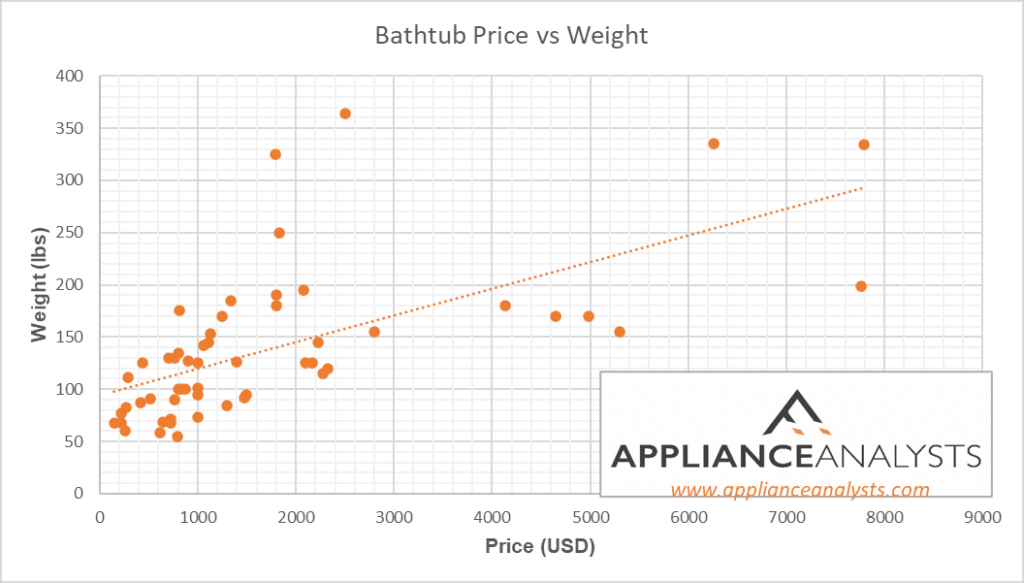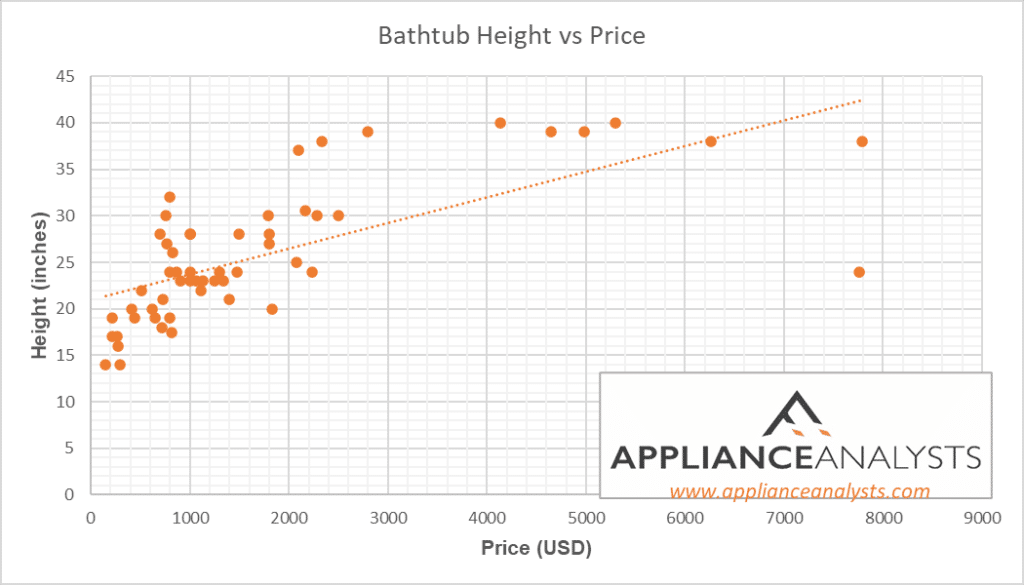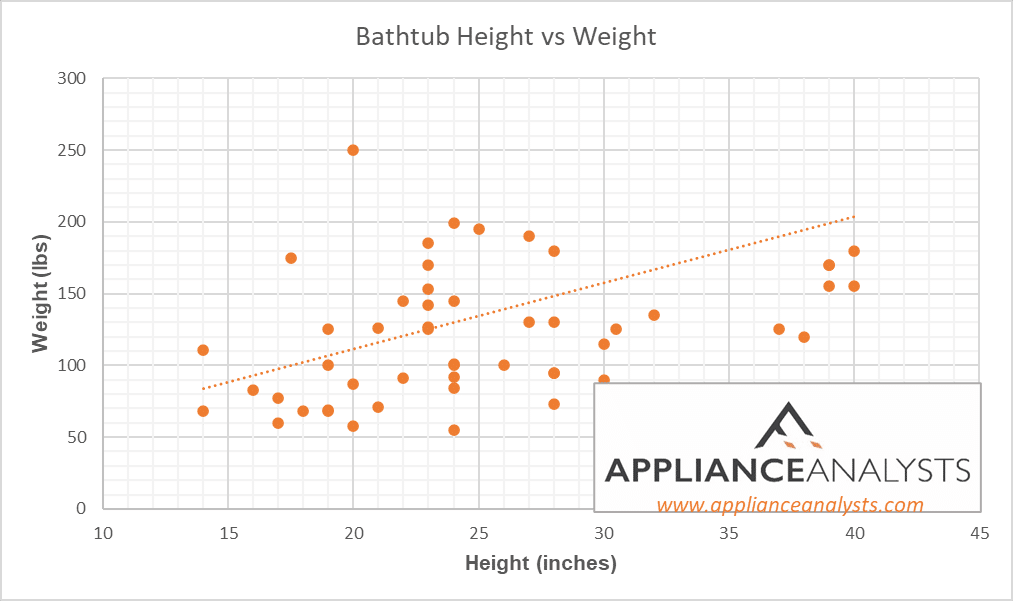We've independently reviewed this article to make sure it's as accurate as we can make it.
To find out more about our article creation and review process, check out our editorial guidelines.
Planning to redesign your bathroom from scratch? Well, that’s a lot of fun!
You can choose everything to your liking, from the faucets to the tiles, to lighting and mirrors – Oh, and who can forget the bathtub!
Taking a bath in the bathtub is relaxing after a long hard day. It really calms your nerves, thus allowing for a good night’s sleep as well.
Choosing a new bathtub can be quite difficult. One of the many factors is the weight of the bathtub, which also impacts other factors. Have you ever wondered how much a bathtub weighs? How do they manage to carry something so heavy and fit it inside your bathroom?
To answer this I compiled the data for more than 50 bathtubs. This data factors in the type, weight, price, and dimensions.
I should note these are all empty weights. The weight of the bathtub increases when it’s full of water, and also when you’re sitting in it!
Bathtub Weight Averages
Here’s a quick rundown of the prices of various types of bathtubs you can find. We’ve made this list based on the data we collected for more than 50 bathtubs from Lowes. We factored in bath dimensions, price, weight, and type of bathtubs as well.
Have a look at the table below.
| Bathtub Type | # Reviewed | Average Weight (lbs) | Average Price |
|---|---|---|---|
| Freestanding | 10 | 100 | $975 |
| Alcove | 10 | 85 | $400 |
| Walk-In | 10 | 190 | $4,255 |
| Drop In | 9 | 130 | $1,645 |
| Clawfoot | 8 | 170 | $1,600 |
| Corner | 8 | 175 | $1,470 |
Analyzing Bathtubs
You may have thought initially the table holds a surprising amount of data for bathtubs. Being a trained engineer, I just can’t resist visualizing some of what it all means. Before we get into the weights per individual bathtub, let’s look at just what bathtub weight and height mean when it comes to your budget.
Bathtub Price vs. Weight
As you might expect, heavier bathtubs tend to cost more. This isn’t always true – a high-end Clawfoot can cost way more than a corner tub – but it’s a good rule of thumb.

Of course, there are a few exceptions to this rule. While most of the heavier bathtubs are priced higher than $4000, a few of them can be bought for as low as $2000.
Bathtub Height versus Price
You might be wondering that I’m focusing a lot on the weight of different bathtubs, and not mentioning their height.
A bathtub’s height directly affects its water depth, so it’s an important factor to take into consideration. As a general trend, the higher the height of your bathtub, the more you’ll have to pay for it. You can see the relation between bathtub height and price in the graph below.

Bathtub Height vs Weight
Since we’re at it, why not compare bathtub height and weight as well? There’s not much to see in the graph below, but it does imply that the taller your bathtub is, the heavier it’ll be.
This supports both of the above graphs. It suggests that both height and weight have a directly proportional relationship with the price.
In this graph, the only outliers you find are clawfoot bathtubs. They have a greater height than most bathtubs, but they’re not necessarily deeper.

Average Bathtub Weights by Type
As you’ve seen in the table above, there are various types of bathtubs you can choose from. Not all bathtub styles work for every person, which is why it’s important to know the difference between each of them.
Let’s have a broader look at these types.
Freestanding Bathtubs
As the name suggests, freestanding bathtubs aren’t fixed or connected to the wall. They stand alone on the floor. They’re generally large in size, which is why you’d need a larger space in your bathroom. Freestanding tubs are a real luxury statement because of this.

Since they’re standalone, freestanding tubs can often be lighter – since they don’t include wall fixtures/connections.
On average, Freestanding bathtubs weigh around 100lbs. Their average dimensions are 65 x 30 x 25 (length x width x height in inches).
The significance of all this is that freestanding tubs cost just under $1,000 on average. This makes them one of the cheaper options (aside from the super-cheap type below).
Alcove Bathtubs
Alcove bathtubs are the most popular type of bathtubs. This is because they can fit exactly in a three-sided space that has been designed to accommodate a bathtub.

They’re much smaller than other types of bathtubs, and they’re also the least expensive in this regard.
On average, Alcove bathtubs weigh around 85lbs. Their average dimensions are 60 x 30 x 15 (length x width x height in inches).
You’ll find the alcove bathtubs with tiles for the three-sided enclosure. Most modern types also come with a three-sided wall surround. These are more functional, but there will be a tight squeeze through the door! For this reason, bathroom doors must be at least 30″ wide per building codes, in order to fit a tub.
Alcove tubs are the perfect choice for smaller bathrooms.
Walk-In Bathtubs
Walk-in bathtubs aren’t something anybody can just walk into!
Walk-in bathtubs have a higher elevation than other bathtubs. They have a door on the side that you can use to “walk-in” and sit inside the tub. They’re specially built for the elderly, as well as people with disabilities.

Walk-in bathtubs are useful for preventing accidents caused due to slipping. They also feature handrails and grips to help people stay above the water and get up without any difficulty.
These types of bathtubs require professional installation, which will add to the costs. They’re the heaviest among all of the bathtub types. Walk-in tubs often go for around a whopping $4,255. Ironically, that price tag makes many people walk out (of the store!)
On average, Walk-In bathtubs weigh around 190lbs. Their average dimensions are 55 x 30 x 35 (length x width x height in inches). They have a water depth of around 30 inches, which is higher than most bathtubs.
Drop-In Bathtubs
Drop-in bathtubs don’t have finished sides, and they’re supposed to fit inside a prepared space. It’s like fitting a bathtub into an alcove.

Since the sides slide into the space, they don’t have to be finished. They just have a finished rim that stays above the surface and is visible.
Drop-in bathtubs are heavier than alcove and freestanding bathtubs. Since they require a prepared space, they have a higher installation cost as well. The cost for a drop-in bathtub is typically around $1,645.
On average, Drop-In bathtubs weigh around 130lbs. Their average dimensions are 65 x 40 x 20 (length x width x height in inches).
The standard dimensions for drop-in bathtubs are similar to alcove bathtubs.
Clawfoot Bathtubs
A clawfoot bathtub is a type of freestanding bathtub that doesn’t require any installation. It has four feet installed underneath it. These feet look like claws, hence their name.

Although the basic design of freestanding bathtubs is the same, you can choose different designs for the feet. Clawfoot bathtubs have finished sides with a lip on their front side, so you can rest your feet on it.
On average, Clawfoot bathtubs weigh around 170lbs. Their average dimensions are 65 x 30 x 30 (length x width x height in inches). They typically retail at around $1,600.
These bathtubs are popular among people who have a taste for vintage styles. Some of the common foot styles are called ball and claw, paw, cannonball, and armada. They’re generally more expensive than other types of bathtubs.
Corner Bathtubs
Corner bathtubs are the more luxurious type of them all. They’re usually found in master bathrooms and are used for calming body soaks rather than regular baths.

When choosing the type of bathtub, you can consider which one would suit your requirements best. More importantly, which one would fit best in your bathroom?
If you’re looking for a bathtub that’s safer for you to use, then the walk-in bathtub is a no-brainer.
Even drop-in bathtubs are quite safe, but they require a whole lot of preparation before you can install them.
So, if you’re looking for a bathtub that isn’t difficult to install, then you can go for either the freestanding tub or clawfoot tub. If you have a three-sided enclosure, then your obvious choice is the alcove bathtub.
If you have sufficient space and need something luxurious, then you can buy a corner bathtub. Of course, you’ll also have to see which one fits your budget.
Did you know? Many bathtubs are either right or left handed. Make sure to buy the version that matches your plumbing to avoid any additional modification costs.
How Much Extra Weight Does Water Add to a Bathtub?
As I mentioned in the introduction, you also have to consider the additional weight water puts on a bathtub. To start off our calculations, keep in mind that a gallon of water has an approximate weight of 8 pounds.
For a standard bathtub, filling it requires around 30 gallons of water. This means that you’re adding around 240lbs (110kg) to the bathtub weight when full (not including anyone in the tub!).
Of course, these values are all based on assumptions, and you can find the actual values by working out your tub’s capacity and multiplying it out to find the added weight.
What’s the Lightest Type of Bathtub?
If we refer to the charts above, we’d find that alcove bathtubs are the lightest type of bathtub. But this also depends on what material they’re made of.
Different types of materials are used to manufacture bathtubs, and this also influences their weight. And since we’ve discussed the relation of bathtub weight with its price, we know that lighter bathtubs are also the cheapest.
Among all of the materials used for bathtubs, plastic is one of the lightest materials to be used.
What’s the Heaviest Type of Bathtub?
Walk-in bathtubs are generally heavier than all of the other types. This, too, depends on the type of materials that are used in its construction.
You might also find corner and clawfoot bathtubs that may be heavier than walk-in bathtubs, especially if they’re made from cast iron.
In fact, most cast iron bathtubs are known to be as heavy as 1,000 lbs! The material from which the bathtub is made also plays a significant role in its weight.
How are Bathtubs Installed?
This is something that may have crossed your mind several times when you glance at your bathtub.
Naturally, the installation method for each type of bathtub is different from the other. Let’s have a brief look at some of the common installation methods.
Freestanding Bathtubs
When installing a freestanding bathtub, you just have to designate a place on the floor for your bathtub. Ensure that the area is completely clean, as you won’t be able to clean underneath your tub once it’s, and that you have the appropriate water, power, and drain connections ready.
Things are different with clawfoot bathtubs, as they can be placed anywhere and also have sufficient clearance space underneath.
Drop-in Bathtubs
As discussed above, drop-in bathtubs don’t have finished sides and are installed into a prepared platform or deck.
Although the installation only takes a few minutes, a major portion of the time and money goes into building the enclosure where the tub is supposed to be lowered and connected. You can attach the drain, overflow, and trap before lowering the tub – but you can’t connect it to the plumbing until it’s already in place.
Alcove Bathtubs
Alcove bathtubs are meant to be installed in a three-sided enclosure. This is why they don’t have a border on one of their longer sides that goes at the back. This makes it easier to install them.
Apart from this, the location of the drain and plumbing determines whether you should opt for a left or right-sided alcove bathtub.
These are the installation methods used for the most popular bathtub types, and the rest of them also have similar methods.
Conclusion
Choosing the right type of bathtub is an important decision.
If you’re going out to buy a new bathtub, make sure to take note of its weight, as well as its dimensions. This way you’ll know whether or not it’ll fit the designated space inside your bathroom or not.
On this note, we’ll conclude this article.
I hope you can now understand how many different types of bathtubs there are. Now you have a general idea of how much they weigh as well.
If this information helped you in any way, wait till you see what more I have in store in my other articles!
Thank you for reading, and have a fantastic day!
-Craig







